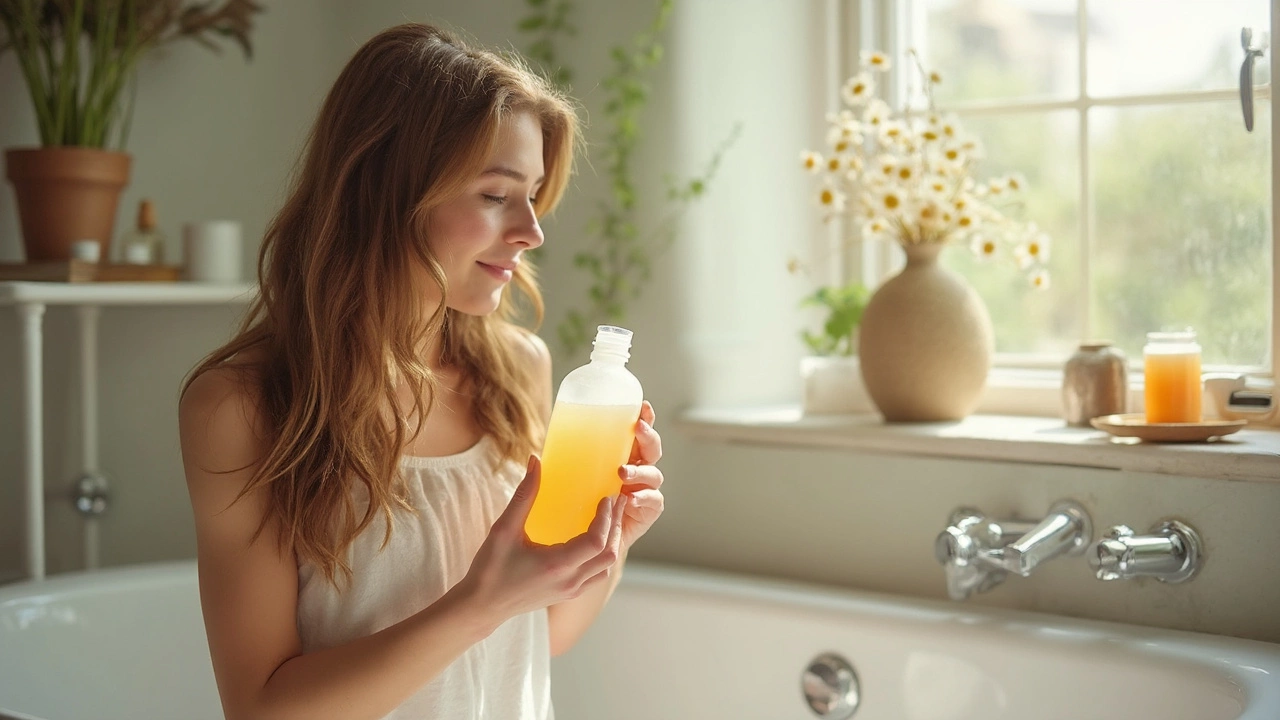
Some people still scrub their hair with whatever’s cheapest on the drugstore shelf, but not all shampoos treat your scalp equally. One quick look at the ingredients list can make you wonder if you’re actually cleaning your hair or pickling it in a potion of tongue-twisting lab creations. Did you know that most commercial shampoos were first made in the 1930s, and most modern formulas haven’t really changed since the 1970s? That’s decades of sudsing with the same strong cleansers that can dry out your scalp, fade your color, and cause stubborn flakiness. Yet, celebs and hair nerds online swear by everything from rye flour to filtered water to goat’s milk. It gets weirder: using just water, aka the “no-poo” method, is surging in popularity. So, what’s the healthiest thing to wash your hair with, truly? Let’s untangle the facts (and some myths) to get straight to glossy, happy hair.
Getting to the Root: Why Typical Shampoos Aren’t Always Healthy
Pick up a bottle of classic shampoo and you’ll see names like sodium lauryl sulfate, cocamidopropyl betaine, and methylisothiazolinone. Sounds clinical, right? Sulfates especially—these are harsh detergents that create big foamy bubbles but also strip away sebum, your hair’s natural protector. Sometimes the result is that squeaky-clean feeling, but your hair isn’t supposed to squeak! What’s really happening is your scalp freaks out from dryness and kicks oil production into overdrive. Next thing you know, you’re in a greasy-hair cycle, constantly scrubbing more, and damaging your scalp’s barrier.
Also, many shampoos contain parabens—preservatives linked to hormone disruption—and artificial fragrances that can irritate sensitive skin. Dermatologists and trichologists (those are the medical hair specialists) confirm more people complain of itchy, red, or flaky scalps due to these harsh ingredients. According to a survey published by the American Academy of Dermatology in 2024, around 36% of people with scalp issues improved just by switching to gentle or natural formulas. That’s not just anecdotal—it’s a real thing.
Another sneaky issue is silicone. It coats strands to make them look shiny but can build up over time, making hair limp and lifeless. Plus, that buildup can block the scalp from breathing and cause more breakouts or itchiness. People with curly, wavy, or textured hair, in particular, often notice more dryness, more frizz, and less curl definition when using shampoos loaded with sulfates, parabens, and silicones.
Mainstream shampoos are also notorious for using strong preservatives and stabilizers, which can mess with your scalp microbiome (yes, you have a mini-ecosystem up there!). When your scalp’s array of helpful bacteria gets out of balance, dandruff, oiliness, and even hair shedding can pop up. So, if you’ve always assumed shampoo was helping, it might be time to question what’s actually going down your drain.
Natural and Gentle Alternatives: What Really Works?
Natural doesn’t always mean better, but with hair care, gentler options tend to leave both your hair and scalp softer, less irritated, and more resilient. Let’s decode some of the top healthy alternatives—and what science says about them.
- Natural shampoo bars: The most-loved solid shampoos usually ditch the sulfates in favor of plant-based cleansers like decyl glucoside or sodium cocoyl isethionate. These bars are concentrated, last for months, and use less packaging. One independent review in 2024 found that over 70% of users noticed less scalp irritation when switching from drugstore shampoo to natural bars for eight weeks.
- Gentle sulfate-free shampoos: Formulas labeled “sulfate-free” use milder surfactants, such as coco-glucoside or disodium laureth sulfosuccinate. If you’re a gym regular or need to wash frequently, these offer a great compromise between cleansing and not drying your hair out. Look for simple ingredient lists and brands transparent about their testing.
- No-poo or low-poo methods: People sometimes skip commercial products altogether, rinsing with just water (“water-only washing”) or using rye flour, chickpea flour, or even apple cider vinegar (ACV) dilutions. This isn’t for everyone—especially if you live in a city with hard water or use lots of styling products—but those with naturally dry or curly hair often swear by it. Diluted ACV can neutralize scalp pH, cut residue, and increase shine, though it’s important not to overdo it (limit it to once every week or two).
- Cleansing conditioners (“co-washing”): These creamy, detergent-free cleansers can work wonders for curls and coils. They gently lift dirt but leave your natural oils intact. They’re not just for the curly-haired—fine, dry, or color-treated hair often loves them too.
- DIY mixes: You’ll find recipes for everything from aloe vera gel mixed with rosemary oil to baking soda scrubs. While it’s fun to experiment, not everything from your kitchen cupboard is safe for your scalp! Some classics, like baking soda, are too alkaline for hair; stick to low-risk options like green tea rinses, oat “milks,” or DIY infusions using gentle herbs like chamomile.
A word of caution: The healthiest thing to wash your hair with depends on your hair type, routines, and scalp quirks. Extremely oily scalps need some cleansing, while parched curls or dyed hair can go longer, using only simple, moisturizing options. You can always alternate traditional and alternative methods or experiment until you hit your sweet spot.

Tips for Healthy Hair Washing: How, When, and How Often?
Washing your hair isn’t just about the bottle you grab—it’s also about how you do it. A few small tweaks in your routine can massively upgrade your hair health and even help regrow lost shine or body.
- Don’t overwash: Daily shampooing is rarely necessary unless you’re oily or sweat a ton. Most people can get away with two to three times a week. If your hair feels dry or your style lasts longer, stretch it—your scalp will eventually adapt and stop overproducing oil.
- Use lukewarm water: Hot water strips away oils and can cause irritation. Stick to warm or even cool water to keep cuticles smooth and your scalp comfortable.
- Massage, don’t scratch: Use your fingertips (never your nails!) to gently massage your scalp for a minute or two. This boosts blood flow, loosens dead skin, and helps your shampoo break down grease without friction.
- Rinse thoroughly: Product buildup is a sneaky cause of dullness and itchiness. Spend an extra minute rinsing, and if you use ethnic or heavy products, consider a monthly clarifying wash (choose a mild clarifying shampoo).
- Apply conditioner to lengths only: Unless you have a very dry scalp, skip conditioner at the roots—it can clog pores and flatten your hair.
- Treat your scalp occasionally: Once or twice a month, try coconut oil, jojoba, or olive oil as a scalp mask before washing—let it sit for at least 30 minutes. Oils with antifungal/antibacterial properties (like tea tree or rosemary essential oil) can also help with flakes, but always dilute them with a carrier oil.
- Skip friction when drying: Blot hair gently with a microfiber towel or an old T-shirt instead of rubbing vigorously with a regular towel, which can break hair.
- Limit heat styling: Give your strands a break from blazing dryers and irons. If you must style, use a quality heat protectant spray.
Sticking to these simple swaps will give your hair and scalp a real break. Notice less frizz, fewer split ends, and a more comfortable scalp within a few weeks.
Science-Backed Ingredients for Healthier Hair
If reading shampoo labels feels like decoding cryptic code, it’s not just you—beauty brands love marketing fluff. But scientists have tested what really supports healthy, strong hair and a balanced scalp. Here are a few to look for if you want the best of both worlds—effectiveness and gentleness:
- Aloe vera: This all-star hydrates, soothes itch, and doesn’t weigh hair down. Studies published in the International Journal of Trichology show aloe can calm flares of seborrheic dermatitis and improve scalp comfort.
- Panthenol (pro-vitamin B5): It binds to the hair shaft, smooths frizz, and boosts moisture retention without turning hair greasy. Lots of salon-grade shampoos add it for more manageability.
- Oat extracts: These natural calmers are a favorite for sensitive or easily irritated scalps. They create a thin film that protects skin and hair both.
- Apple cider vinegar (ACV): When properly diluted (think one part ACV to ten parts water), it can lower scalp pH, cut oil, and nix dullness—no wonder it’s a top home remedy for shiny hair.
- Tea tree oil: Used sparingly and always diluted, it’s proven antimicrobial and helps fight dandruff and itchiness. A few drops in a palmful of mild shampoo can go a long way.
- Gentle botanical cleansers: Look for names like coco-glucoside, lauryl glucoside, or decyl glucoside if you want effective foam without stripping your scalp. They’re derived from coconut, corn, or sugar and less likely to cause irritation.
- Hydrolyzed proteins (like silk or wheat): These add a bit of strength and shine, especially helpful for damaged hair or after sun exposure.
Don’t get swayed by overstuffed labels. A short, transparent ingredient list is usually better. And don’t feel pressured to spend a fortune—many small indie brands or even big retailers now offer options that tick all the boxes: sulfate-free, pH balanced, no parabens, and minimal scent.
Switching to a healthier way to wash your hair often surprises people. Within a couple weeks, you don’t just see less dryness and breakage—lots of people say their color lasts longer, curls bounce better, and their scalp feels calm for the first time since, well, ever. Remember, the healthiest thing to wash your hair with isn’t a magic bottle. It’s about gentle care, smart ingredients, and maybe a little trial and error. Once you find what works, those good hair days are here to stay.